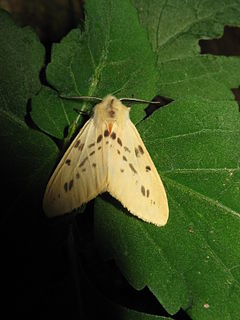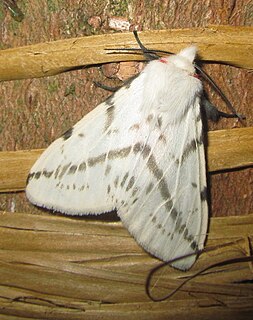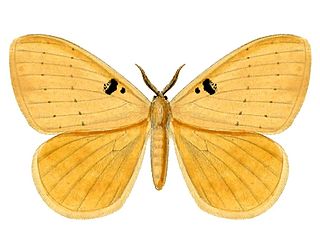Garudinia is a genus of moths in the subfamily Arctiinae first described by Moore in 1882.

Lomographa bimaculata, the white-pinion spotted, is a species of geometer moth. It belongs to the large geometer moth subfamily Ennominae, and therein to the tribe Baptini. It is – under its junior synonym – the type species of its genus Lomographa. It is also the type species of Bapta, a junior objective synonym of Lomographa and the namesake of the Baptini. The species was first described by Johan Christian Fabricius ion 1775.

Lemyra is a genus of tiger moths in the family Erebidae. The genus contains many species from East and South Asia, Sundaland and Australia. It was described by Francis Walker in 1856.

Minucia is a genus of moths in the family Erebidae. The genus was erected by Moore in 1885.

Euproctis is a genus of tussock moths in the family Erebidae described by Jacob Hübner in 1819. Species are cosmopolitan, widespread throughout Palearctic, African, Oriental and Australian regions. Molecular phylogenetic studies indicate that the genus as presently understood comprises a large number of unrelated lineages, only a few of which have names, and is therefore in serious need of revision.

Lemyra venosa is a moth of the family Erebidae first described by Frederic Moore in 1879. It is found in India in Sikkim and the Khasia Hills and in Bhutan.

Lemyra punctilinea is a moth of the family Erebidae first described by Frederic Moore in 1879. It is found in Sichuan, Shaanxi, Yunnan, Pakistan, Kashmir, the Himalayas, Assam and Nepal.

Lemyra inaequalis is a moth of the family Erebidae first described by Arthur Gardiner Butler in 1879. It is found in Japan and Korea.
Lemyra obliquivitta is a moth of the family Erebidae. It was described by Frederic Moore in 1879. It is found in China, Nepal, Bhutan, India, Myanmar and Thailand.
Lemyra anormala is a moth of the family Erebidae. It was described by Franz Daniel in 1943. It is found in China, Burma and Vietnam.
Lemyra biseriata is a moth of the family Erebidae. It was described by Frederic Moore in 1877. It is found in India and Nepal.
Lemyra costimacula is a moth of the family Erebidae. It was described by John Henry Leech in 1899. It is found in China.
Lemyra flammeola is a moth of the family Erebidae. It was described by Frederic Moore in 1877. It is found in China.
Lemyra flavalis is a moth of the family Erebidae. It was described by Frederic Moore in 1865. It is found in China, Nepal, India, Bhutan and Myanmar.
Lemyra hyalina is a moth of the family Erebidae. It was described by Cheng-Lai Fang in 1990. It is found in China in Guangxi and Guangdong.

Lemyra multivittata is a moth of the family Erebidae. It was described by Frederic Moore in 1865. It is found in Nepal, India, Myanmar and China.
Lemyra rubidorsa is a moth of the family Erebidae. It was described by Frederic Moore in 1865. It is found in Pakistan (Kashmir), India and China.
Lemyra sikkimensis is a moth of the family Erebidae. It was described by Frederic Moore in 1879. It is found in India and China.

Lemyra stigmata is a moth of the family Erebidae. It was described by Frederic Moore in 1865. It is found in China, Pakistan, India, Nepal, Bhutan, Myanmar, Thailand and Vietnam.

Catajana is a monotypic moth genus in the family Eupterotidae described by Embrik Strand in 1910. Its only species, Catajana bimaculata, described by Hermann Dewitz in 1879, is found in Angola and the Democratic Republic of the Congo.







